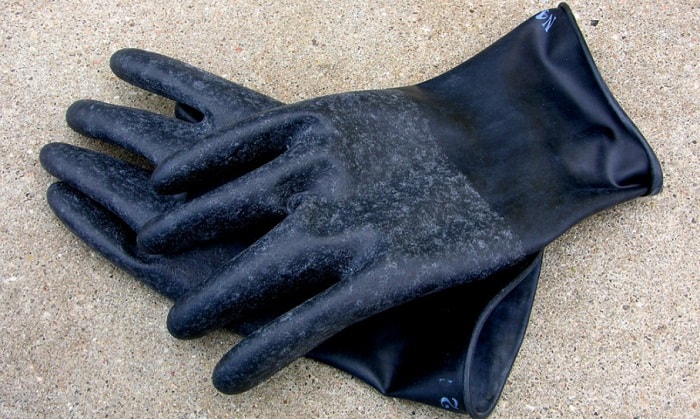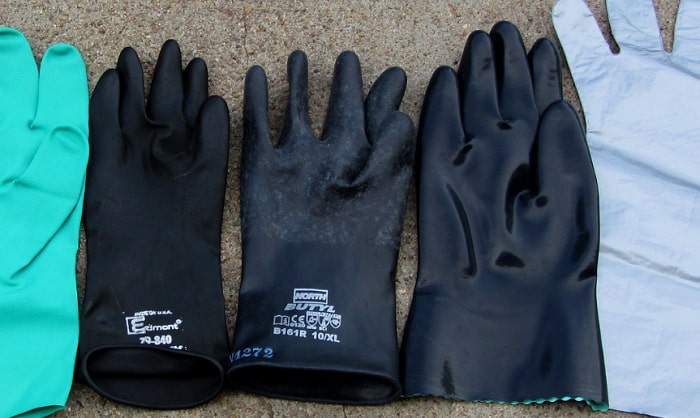Butyl gloves’ definition is simple. They are gloves made of butyl – a synthetic rubber. It is the first rubber to be synthesized in history and is the only one that air and water vapors can’t pass through. Surprisingly, this rubber is also the main ingredient of bubble gums.
Butyl is the result of polymerization isobutylene and a small portion of isoprene. Below, you can find a more detailed answer to “What are butyl gloves made of?”, as well as the gloves’ applications and limitations.
Table of Contents
Butyl Gloves Material
Butyl rubber gloves are made of butyl – a synthetic rubber, which was developed in 1937. A few years later, the rubber was commercialized and applied widely in different industries.
Butyl rubber is the result of polymerizing 98 to 99% of isobutylene and 1 to 2% of isoprene. The added isoprene allows the rubber molecules to bind together when manufacturers run them through a vulcanizing process.
Vulcanization ties all the molecules together to form a large rubber molecule that won’t weaken when extreme temperatures hit. You might be familiar with the name Charles Goodyear. He invented the vulcanizing process in 1839.
This video will inform you about the chemical structure of butyl:
The rubber’s tight molecule structure makes it highly resistant to air, gas, and water vapors. Hence, it is for applications requiring an airtight substance, such as adhesives, fiber optic compounds, sporting equipment, and chemical-resistant gloves.
Applications of Butyl Gloves
1. Chemical handling procedures
Butyl gloves protect against a wide range of chemicals, such as peroxide, strong bases, and highly corrosive acids. It also resists aldehydes (mostly used in the perfume industry), alcohols, esters, ketones, and nitro compounds.
Besides chemicals, the material is resistant to ozone, heat, and weathering. You can find a full description of what butyl gloves protect against in the OSHA Glove Selection Chart.
2. Electrical work
Electricians deal with both electrical and physical hazards (cuts, punctures, abrasions). In addition to offering good electrical insulating properties, butyl can withstand tear and impact thanks to its tight molecule structure. You can see this rubber in many electrical insulating work gloves.
3. Tasks involving high temperature
Butyl rubber remains flexible and reliable between -50 and 250°F (-45°C and 120°C). An experiment showed that butyl gloves could withstand a temperature of 212°F (100°C) for up to 48 hours.
They can help workers in hot working conditions, mining, or other high-temperature handling procedures. The gloves also age well under such harsh conditions, so workers can rely on them to protect their hands.
4. Tasks involving vibration
Operating powered vibrating tools for an extended period causes negative health effects. Wearing the right gloves will help block the vibration transmission, thus protecting you from the health issues they might bring, such as hand-tingling or hand-arm vibration symptoms.
Most rubber can dampen and absorb shock and vibration, so is butyl. Since it is more durable, manufacturers prefer it for anti-vibration gloves to natural rubber. Your anti-vibration mounts and pads are also from butyl.
Limitations
Even though butyl gloves offer numerous benefits, there are no such things as the perfect gloves. These pairs come with limitations.
The tight molecule structure of butyl gloves traps air and heat, making the wearer sweat excessively. Manufacturers must mix it with other rubber to make the gloves more breathable and comfortable. Butyl is also vulnerable to flame. Despite its resilience and ability to deal with heat, it can’t assist in the kitchen.
You shouldn’t wear butyl gloves to handle oils, aromatic hydrocarbons, aliphatic hydrocarbons, tar, coal, and most lubricants. At high temperatures, its damping function also diminishes.
Compared with natural rubber, butyl is more expensive due to its demanding manufacturing process. But it is more resilient and long-lasting. When one pair of thin butyl gloves lasts for months, its value equals hundreds of disposable latex gloves.
Is Viton Rubber the Same as Butyl
Gloves that are chemically resistant are usually made from Viton or butyl. Still, don’t mistake them for one another; they are made of two different polymers. Each type protects against different chemicals and hazards.
Viton provides high resistance to fuels, aromatic hydrocarbons (which butyl can’t protect against), benzene, toluene, or xylene. Due to the high production costs, Viton is mostly used in the aerospace industry or to handle highly toxic compounds.
Are Butyl Gloves Available in Different Thicknesses and Styles
Depending on the butyl gloves’ purpose, they can be made in different thicknesses and styles. Besides disposable butyl gloves, you will find heavy-duty ones in the market.
Their thicknesses range from 0.3 to 14 mil (1 mil = 1/1000 inch). Thicker gloves provide higher protection, while thinner gloves allow more dexterity and flexibility. When choosing gloves for your job, you must assess the job’s requirements carefully to come up with the best decision.
Unfortunately, butyl gloves don’t come in a wide range of colors. You will find them mainly in black. If you have two pairs of gloves for two different tasks, this might be problematic. Since butyl gloves are often more costly, save them for the job that needs them most.
Conclusion
To sum up, butyl gloves are made of synthetic rubber that contains 98% of isobutylene. Manufacturers add 2% of isoprene to strengthen the rubber’s molecule structure and name it butyl for commercial use.
Where chemical hazards are a concern, you must equip yourself with knowledge and the right protective gear to keep you and the others safe. With this article of what are butyl gloves made of, we’re confident that you understand the components of butyl gloves and apply them correctly at your workplace. So, tell a friend this information to spread the knowledge. Thank you for reading!

Veronica is our content editor. She is a talent in delivery. Her main work is editing and writing articles that are both informative and simple to follow. She is in charge of synthesizing our understanding of what personal protection equipment (PPE) is needed in each job, how to best apply it, and how to visualize that equipment.




